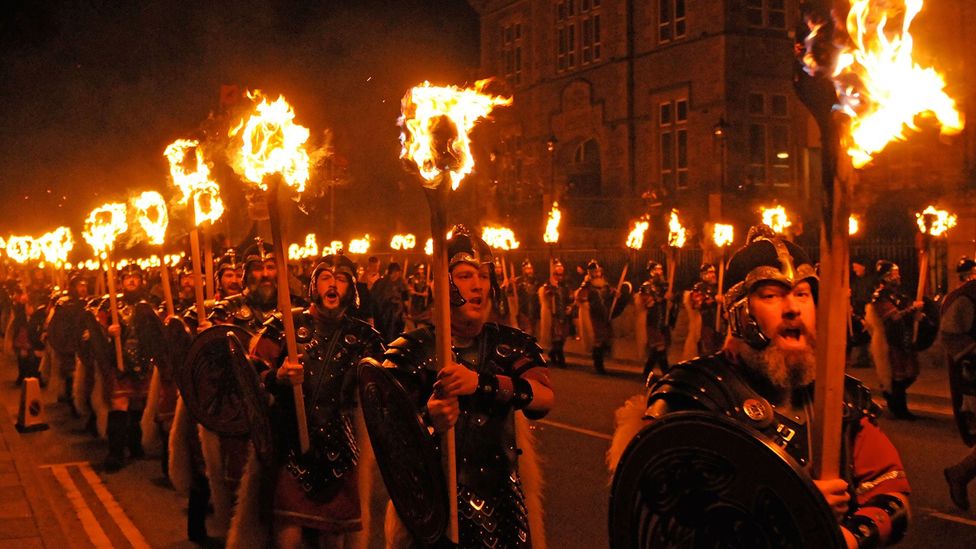It was 08:00 but the sunrise was only just beginning to blush the corners of the long January night in Lerwick, the capital of Scotland's Shetland archipelago. A couple of fireworks boomed overhead as a group of men passed around a hipflask of whisky – the best defence against the bone-chilling wind that rattles through the Shetland Islands like a poltergeist all winter.
There was a commotion behind the doors of a huge hangar-like shed, which swung open to reveal a vast wooden longship, 30ft from stern to prow, carved in the form of a fearsome dragon and painted a glacial blue. This was the galley, the ceremonial burning of which would happen later that night as the focal point of the festival of Up Hellya Aa – a pyromaniac celebration of the return of the light after winter and an honouring of Shetland's proud Norse heritage.
From around the corner came the pounding of feet, the clatter of steel and the swelling sound of drums, punctuated with loud battle cries: a marauding gang of Vikings, known as the "Jarl Squad", who are the main players in the festivities. They would be spending the day parading the galley through town in resplendent Viking clothing – turquoise cloaks, winged helmets, axes and shields – while stopping off at various points to sing Norse songs; pose for photos; and eat, drink and make merry. The leader of the squad, elected 15 years in advance, is known as the "Guizer Jarl" and dresses up as a historical Viking; this year's incumbent, the magnificently bearded Richard Moar, chose Haraldr Óláfsson, who died in a shipwreck off Shetland's south coast in 1248.
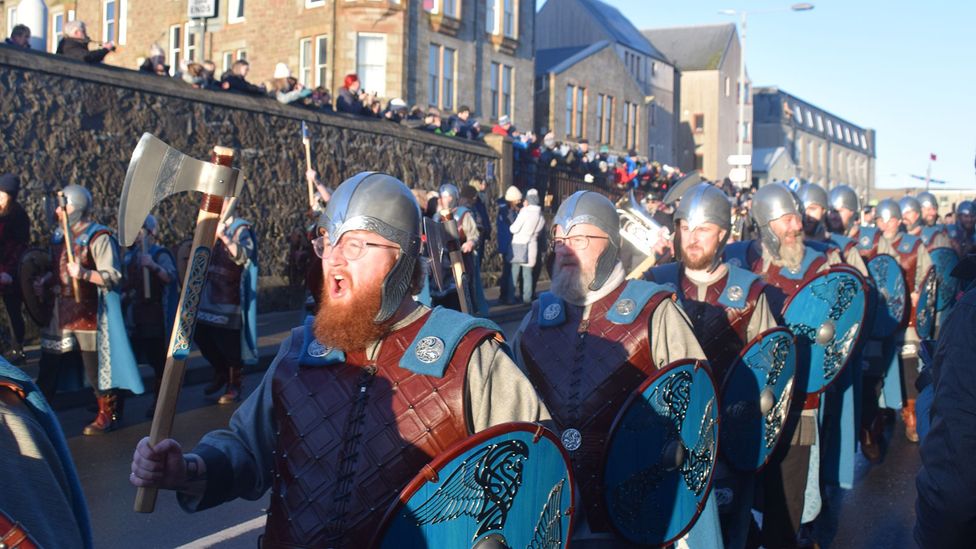
Up Helly Aa takes place in Lerwick on the last Tuesday in January every year (Credit: Daniel Stables)
In 2024, Viking culture also took its initial, tentative steps into the 21st Century: for the first time, women and girls were participating as members of the Jarl Squad.
"This is our New Year, really – we don't go in for Hogmanay so much," said Lyall Gair, who served as Guizer Jarl in 2017 and was helping to marshal this year's procession. "Burning the galley each year and building a new one is a symbol of starting afresh. But it also gets you through the winter – it's something to do!"
The galley, like the Jarl Squad's costumes, is built entirely by locals, amateurs who give up their evenings voluntarily between October and late January. "This is supposed to mark the end of our winter, but it never quite does," Gair said. "So, we just burn, and burn and burn."
Up Helly Aa is just one manifestation of the Shetland Islands' strong Nordic influence, which sits 200 miles west of Norway and was part of the Kingdom of Norway until 1472. Cultural cross-pollination with Scandinavia has continued in the centuries since.
We're right in the midpoint between Norway, the Faroe Islands, Greenland, Iceland, America and Scotland. But sometimes we feel more Scandinavian than Scottish
"Shetland is like the Grand Central Station of the waterways," Shirley Mills, the head of the Shetland Fiddlers' Society, told me. "We're right in the midpoint between Norway, the Faroe Islands, Greenland, Iceland, America and Scotland. But sometimes we feel more Scandinavian than Scottish."
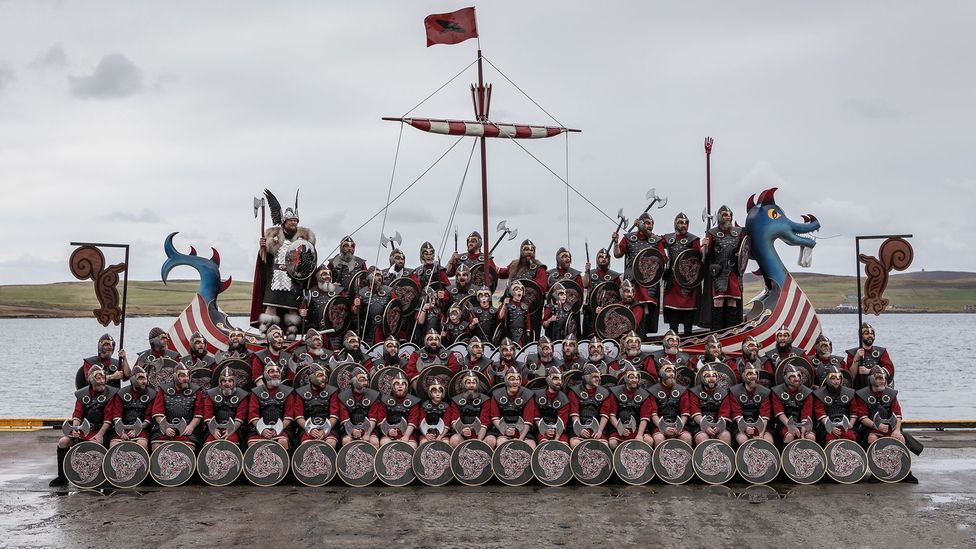
As part of the festivities, volunteers build a Viking galley that is paraded through the streets and ceremonially burned (Credit: Andrew J Shearer/Getty Images)
Shetland's folk music, like that of Norway, is based around the fiddle rather than the bagpipes ubiquitous in mainland Scotland. Folk songs tell of trows, mischievous creatures analogous to Scandinavian trolls who are said to have taught the islanders many of their fiddle tunes.
Where and when to celebrate
The Lerwick event is held on the last Tuesday of each January, but the full Up Helly Aa season carries on burning until mid-March, when there's no doubt the sun is coming back. There are 11 festivals in total, in different towns and villages across Shetland's islands; Lerwick Up Helly Aa is by far the biggest, with 900 torch bearers in the main evening procession
The town centre of Lerwick (pop: 7,000) is criss-crossed with streets named for King Harald, St Olaf and King Haakon. Among the grey sandstone buildings are colourfully painted ones, built from wood or corrugated metal, looking like Icelandic fishing huts.
Outside town, road signs give place names in both English and Old Norse. I was staying in the village of Veensgarth (Vikingsgarðr; Vikings' Farm). The neighbouring hamlet was called Tingwall (Þingvǫllr; Parliament Field), sharing its translated name with the Icelandic site Þingvellir, the site of the world's oldest parliament. Similarly, it was in Tingwall, on a small promontory at the end of a loch, where Shetland's first parliament was held between the 13th and 16th Centuries.
Nordic echoes also dance on the tongues of speakers of Shetland, the Indigenous language of the islands (it's also known as Shaetlan and Shetlandic). Shetland is often referred to as a dialect of Scots rather than a language in its own right – but that is a political distinction, linguist Viveka Velupillai told me as we sat in her living room at Uradale Farm, near the village of Scalloway. "Analysis shows that Shaetlan is more different from Scots and English than Swedish is from Norwegian, yet they are considered separate languages. As linguists say, a language is a dialect with an army and navy," she said. "We estimate that between 30-50% of Shetlanders speak Shaetlan, but we don't have exact figures because it's not included as an option on the census."
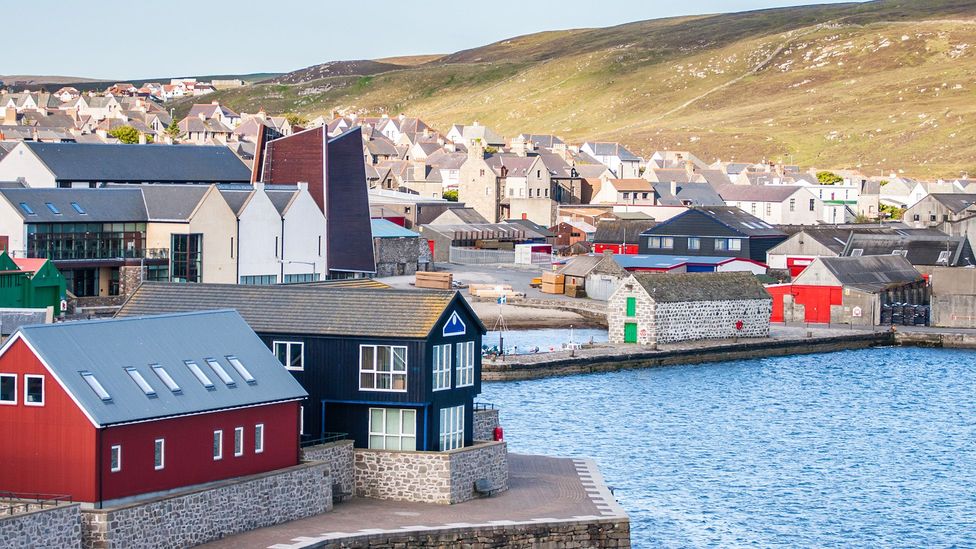
Clues to the Shetlands' Norse heritage can be seen in Lerwick's street names and colourful buildings (Credit: Aiaikawa/Getty Images)
Shetland's main ancestors are Scots and Norn, an extinct language derived from Old Norse whose last speaker died in 1850. Words of Nordic origin are still heard in Shetland: filsket, meaning "mischievous high-spiritedness"; du meaning "you"; and dat meaning "that", for example.
With the rise of English over the last 200 years, however, Shetland has been stigmatised – it has vanished from use in schools, and Shetlanders have been conditioned to think of their language as a coarse vernacular, inappropriate for formal or official use. "To this day, Shetlanders refer to speaking English as 'speaking proper'," Velupillai said.
Her project, I Hear Dee, seeks to change these attitudes and to raise the profile of Shetland, both among speakers and outsiders.
Before I left Uradale, Velupillai showed me a collection of Fair Isle knitwear, which she makes herself from the farm's organic yarn, collected from native Shetland sheep – one of the smallest British breeds, and among the most ancient. Fair Isle knitwear is one of Shetland's most famous exports, and, again, it carries a strong Scandinavian influence with its colour schemes and geometric patterns recalling Icelandic and Norwegian styles.
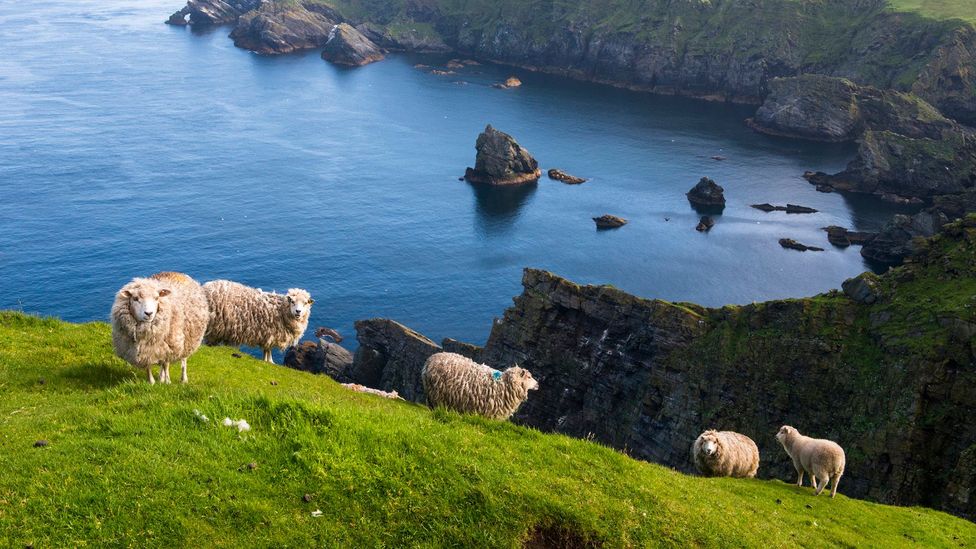
Native Shetland sheep are one of the smallest British breeds (Credit: James Warwick/Getty Images)
Keen to learn more, I headed back to Lerwick and visited the workshop of Joanna Hunter, whose company, Ninian, sells traditional Shetland knitwear. "The patterns might look similar but look closely and you'll see a huge variety," she said, showing me jumpers, hats and scarves. "Shetland knitwear is associated with Fair Isle [the southernmost of the Shetland Islands], but every island has its own style – different colours, vertical panels rather than horizontal stripes and so on. There are endless combinations." Shetland Wool Week attracts textiles enthusiasts and professionals from across the world each autumn and is the only event in the calendar that rivals Up Helly Aa for size and significance.
"Knitting is central to Shetland identity," Hunter said. "It supplemented the crofting [traditional farming] life – women knitted while the men were at sea." She showed me a leather knitting belt, a traditional tool that allowed people to knit and walk at the same time. "There were never any idle hands on Shetland," she said.
As night came on, Lerwick was plunged into further darkness as all its streetlights were switched off, throwing into bright relief a shining moon and the glimmering lights of oil tankers bobbing on the North Sea. A flare gun cracked a red trail through the black sky and the Jarl Squad began their evening procession, this time accompanied by hundreds of people, all holding blazing wooden torches that blew clouds of sparks and the smell of paraffin across town. The galley lay waiting in a park in the town centre; the procession converged on the boat, throwing their torches onto it one by one.
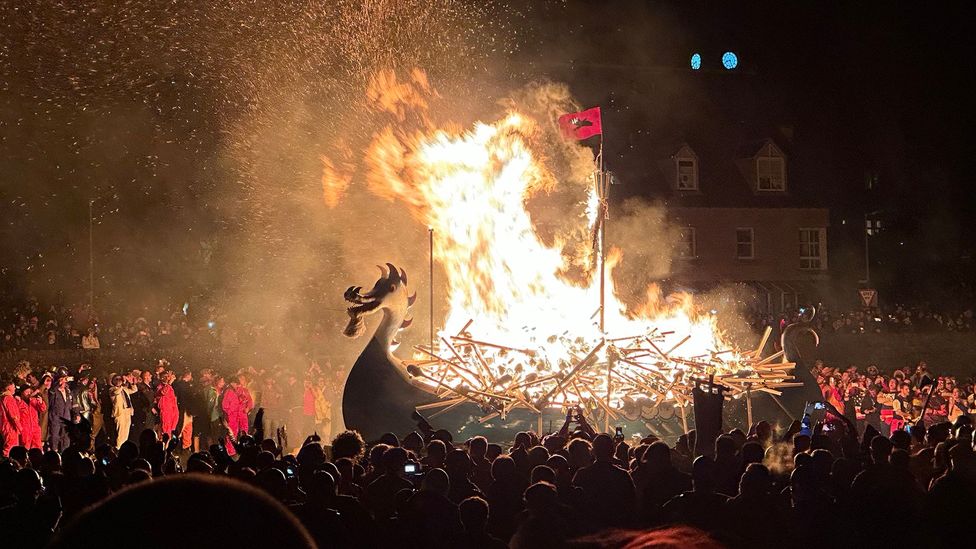
The burning of the Viking ship symbolises the return of the light after winter (Credit: Daniel Stables)
As the boat went up in flames, 11 "halls" across Lerwick – the town hall, primary schools, community centres – began gearing up for a party that would last until the middle of the next morning.
Mountains of sandwiches, free-flowing alcohol and fiddle and accordion bands are the fuel for a night of folk dancing and performances by roving "squads", who travel between the venues putting on comedy skits and dance routines.
The following day is a public holiday here, which is just as well; like their Viking ancestors, today's Shetlanders know that the best way to start a new year is with a monumental hangover.
---
Join more than three million BBC Travel fans by liking us on Facebook, or follow us on Twitter and Instagram.
If you liked this story, sign up for The Essential List newsletter – a handpicked selection of features, videos and can't-miss news delivered to your inbox every Friday.
